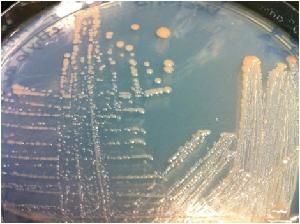
Rhodotorula are pink pigmented, unicellular yeasts isolated from a diverse range of environments including soil, plants, waste water, spoiled food, air samples, and glaciers. Strain JG-1b is a psychrotrophic yeast, with a growth temperature range from 30°C to at least -10°C, that was isolated from permafrost soils in University Valley, an Upper McMurdo Dry Valley in Antarctica. Other psychrophyllic and psychrotrophic Rhodotorula strains have been isolated to date, including R. svaldbardensis, R. psychrophila, R. psychrophenolica, and R. glacialis, the latter two of which can degrade high concentrations of phenol as sole carbon sources.
Microorganisms in permafrost environments are thought to inhabit salty films of water within the soil matrix at sub-freezing temperatures, and thus many permafrost isolates exhibit halotolerance to high concentrations of salt. JG-1b is tolerant to up to 15% NaCl and 12% perchlorate, a powerful freezing point depressant. The genome of JG-1b was sequenced with other cold-adapted permafrost bacterial and archaeal isolates with the goal of identifying the genes and molecular traits which enable cryophillic organisms like JG-1b to thrive in cold and extreme environments. Genes which are known to be relevant for cold adaptation such as those involved in osmotic stress, compatible solute production and uptake, cold and heat shock proteins, and chaperones will be examined.
The availability of other Rhodotorula genome sequences (strain WP1) along with the sequenced genomes of other cold-adapted strains will enable researchers to identify novel cold adaptive traits at the molecular level. JG-1b is also of interest given the degradative capacity of yeasts and the useful applications for cryophillic yeasts in health, agriculture, and industry.
Author: Jackie Goordial
Genome Reference(s)
Goordial J, Raymond-Bouchard I, Riley R, Ronholm J, Shapiro N, Woyke T, LaButti KM, Tice H, Amirebrahimi M, Grigoriev IV, Greer C, Bakermans C, Whyte L
Improved High-Quality Draft Genome Sequence of the Eurypsychrophile Rhodotorula sp. JG1b, Isolated from Permafrost in the Hyperarid Upper-Elevation McMurdo Dry Valleys, Antarctica.
Genome Announc. 2016 Mar 17;4(2):. doi: 10.1128/genomeA.00069-16
